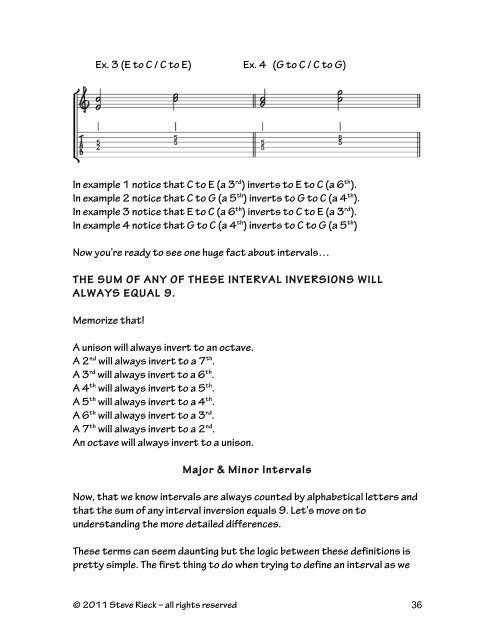Fretboard Evolution Vol. I - Steve Rieck
Fretboard Evolution Vol. I - Steve Rieck
Fretboard Evolution Vol. I - Steve Rieck
Create successful ePaper yourself
Turn your PDF publications into a flip-book with our unique Google optimized e-Paper software.
Ex. 3 (E to C / C to E) Ex. 4 (G to C / C to G)<br />
In example 1 notice that C to E (a 3 rd ) inverts to E to C (a 6 th ).<br />
In example 2 notice that C to G (a 5 th ) inverts to G to C (a 4 th ).<br />
In example 3 notice that E to C (a 6 th ) inverts to C to E (a 3 rd ).<br />
In example 4 notice that G to C (a 4 th ) inverts to C to G (a 5 th )<br />
Now you’re ready to see one huge fact about intervals…<br />
THE SUM OF ANY OF THESE INTERVAL INVERSIONS WILL<br />
ALWAYS EQUAL 9.<br />
Memorize that!<br />
A unison will always invert to an octave.<br />
A 2 nd will always invert to a 7 th .<br />
A 3 rd will always invert to a 6 th .<br />
A 4 th will always invert to a 5 th .<br />
A 5 th will always invert to a 4 th .<br />
A 6 th will always invert to a 3 rd .<br />
A 7 th will always invert to a 2 nd .<br />
An octave will always invert to a unison.<br />
Major & Minor Intervals<br />
Now, that we know intervals are always counted by alphabetical letters and<br />
that the sum of any interval inversion equals 9. Let’s move on to<br />
understanding the more detailed differences.<br />
These terms can seem daunting but the logic between these definitions is<br />
pretty simple. The first thing to do when trying to define an interval as we<br />
© 2011 <strong>Steve</strong> <strong>Rieck</strong> – all rights reserved 36


